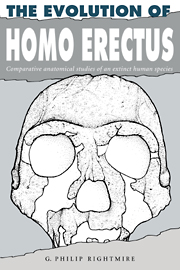Book contents
- Frontmatter
- Contents
- Preface
- 1 Introduction
- 2 Homo erectus in the Far East
- 3 Homo erectus at Olduvai Gorge
- 4 Discoveries from the Turkana basin and other localities in sub-Saharan Africa
- 5 Northwest Africa
- 6 Comparisons of African hominids with Asian Homo erectus
- 7 Homo erectus as a paleospecies
- 8 The transition to more modern forms
- 9 Summary and prospects for further research
- References
- Author index
- Subject index
9 - Summary and prospects for further research
Published online by Cambridge University Press: 14 October 2009
- Frontmatter
- Contents
- Preface
- 1 Introduction
- 2 Homo erectus in the Far East
- 3 Homo erectus at Olduvai Gorge
- 4 Discoveries from the Turkana basin and other localities in sub-Saharan Africa
- 5 Northwest Africa
- 6 Comparisons of African hominids with Asian Homo erectus
- 7 Homo erectus as a paleospecies
- 8 The transition to more modern forms
- 9 Summary and prospects for further research
- References
- Author index
- Subject index
Summary
Nearly a century has passed since this species was first described by Eugene Dubois, but the story of Homo erectus is still incomplete. This is so partly because the record itself is sparse. The fossils assembled by Dubois, von Koenigswald and later collectors in Indonesia, and the specimens recovered at Olduvai Gorge and in the Turkana basin, are sampled from only a tiny fraction of the populations which lived during the Early and Middle Pleistocene. Despite a fairly steady flow of lesser finds, highlighted by occasional spectacular discoveries, the Homo erectus hypodigm is far smaller than the body of material available to any paleontologist investigating other mammalian groups. There are also continuing problems with chronology, particularly at the Asian sites. In Indonesia, the fossils from Ngandong and Sambungmachan are undated, and there is still doubt concerning the stratigraphic provenience of specimens picked up at Sangiran. In East Africa, fortunately, the situation is clearer, as many of the sites contain tuffs that can be dated unambiguously.
Other uncertainties stem not so much from gaps in the record as from questions about species and the evolutionary process. The nature of species, how speciation occurs, rates of evolutionary change and how these should be measured are topics much discussed by molecular biologists, geneticists, ecologists and other students of living organisms. It is not surprising that paleontologists may (also) disagree on how species are to be defined or about the course of evolution within a lineage, even when plenty of fossils are available.
- Type
- Chapter
- Information
- The Evolution of Homo ErectusComparative Anatomical Studies of an Extinct Human Species, pp. 234 - 238Publisher: Cambridge University PressPrint publication year: 1990

